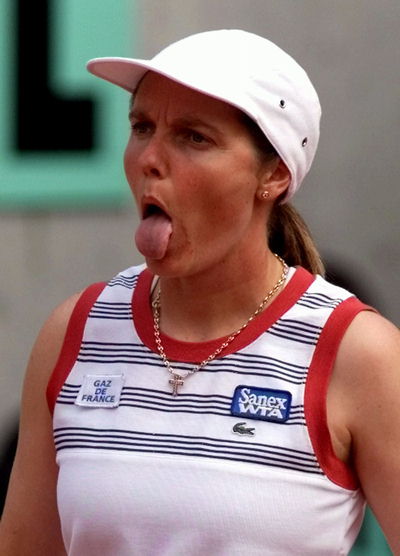Women's Tennis: The Marketing Model
Part 4: The Next Wave
Women’s tennis now consistently outpaces men
in TV ratings. Between 1997 and 2000, more viewers watched
the women’s finals than the men’s finals in eight of twelve
Grand Slams. The British cosmetics company Sanex is the tour’s
namesake sponsor and prize money, topping a twenty-nine year
growth spurt at $47 million, is bigger than ever. The WTA
also has a deep well of talented and marketable players.
Venus Williams recently
extended her contract with Reebok for $40 million, the largest
contract ever for a female athlete. Arnon Milchan said in
the London Observer
that Martina Hingis has developed a taste for "paste jewelry
and split dresses." As for Anna Kournikova, her off-court
success and marketing wit set new standards for player promotion.
Not everyone in the WTA,
though, agrees with its use of sexy selling points. French
player Nathalie Tauziat has published an unflinching critique
of the women’s tour in a book called "Les Dessous du Tennis
Femin" (The Underside of Women’s Tennis). In
it she calls out tournament directors and agents for allowing
"aesthetics and charisma" to trump "sporting performance."
|
 Nathalie Tauziat sticks her tongue out at women's
tennis marketing today
Nathalie Tauziat sticks her tongue out at women's
tennis marketing today
(La Page de Nathalie Tauziat)
|
Not surprisingly, Tauziat
is especially wary of the Anna phenomenon. "For the WTA
Anna is a real cash till," she writes. "Everyone around
her competes with each other to sell her image as Lolita
with the perfect figure. Who else but Anna could inspire
a TV programme [sic] on the trouble line judges have in
concentrating when they are seated behind her?
"If she
obtains results to match her beauty, Anna will be the most
adored player in history," admits Tauziat. "If she fails,
the system can crush her."
In her book, Tauziat also
alleges that the WTA and select tournament officials have
drawn up a secret "Commitment List." The list commits 20
players and ranks them on their ability to fill stadiums.
Throughout 1999, Tauziat
was a mainstay in the women’s top ten. On the "Commitment
List" she ranked number 15. By fulfilling her commitment
to appear in a specified number of WTA tour events, she
was paid $15,000. Kournikova, who peaked at number 15 in
world rankings that year, was 6th in terms of marketability
and stood to collect $100,000 in commitment bonuses.
The WTA would not comment
on the "Commitment List."
Marketers
of women’s tennis follow closely cultural trends. For further
evidence, one needs only to look at a recent press release
for 15-year old American prospect Monique Viele. It reads:
"She rivals a champion thoroughbred with her physical grace
and beauty. Her long, lean, tanned, muscular legs are both
an attribute to her good looks and her speed on the court…
She looks more like a supermodel than a tennis player."
Cha-ching.
|



